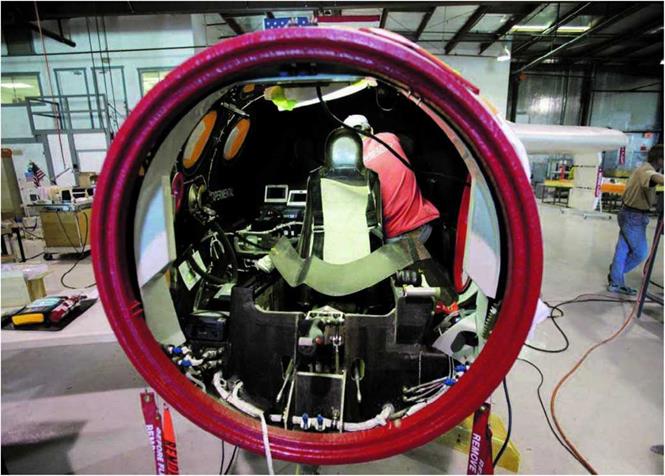Doors and Windows
One of the more distinguishing features of SpaceShipOne is its windshield, made of sixteen 9-inch- (23-centimeter-) diameter windows. The windows are small and round to keep the weight low and the structural strength high. Good visibility for the pilot flying SpaceShipOne, during all phases of the mission, was an important design consideration. This determined the arrangement of the windows.
With a slight tilt of the head, the pilot could always keep the horizon in sight. For one of SpaceShipOne’s rocket-powered flights, this proved crucial when the avionics display went temporarily blank. However, similar to the Spirit of St. Louis, the windows do not allow the pilot to see directly ahead of the spacecraft during landing.
Each window has dual panes and dual seals. This redundancy helped prevent loss of cabin pressurization in the case of damage to a window. The outer panes are 5/16-inch – (0.79-centimeter-) thick, heat-resistant Lexan polycarbonate. They are separated by a 1 /4-inch (0.64-centimeter) gap from 5/16-inch – (0.79-centimeter-) thick Plexiglas inner panes. There are small vent holes in the outer panes to help prevent the window from fogging up. The inner panes took all the pressurization and when loaded, could deflect 0.2 inches (0.5 centimeters). Even if the inner panes failed, the leak rate would be very low, and SpaceShipOne could easily glide back home. Airliner windows also commonly use a two-pane construction with vent holes.
The crew entered SpaceShipOne through a 26-inch – (66-centimeter-) diameter, dual-sealed plug door on the port side. The door does not have an external handle but does have an internal handle that the crew could grab and pull out. Just like the plugs on the sides of the cockpit, it is shaped so that the pressure inside the spaceship held the door in place.
The spacecraft was not designed to have ejection seats, in order to help keep the cost, weight, and complexity at a minimum.

 The nose cone was an escape hatch. Once it was unlocked, the pilot uses a handle near his left foot to turn the nose cone on its gear ring. After a clockwise turn of only 7.5 degrees, the nose cone detached and fell free from SpaceShipOne. Figure 4.18 and figure 4.19 both show views after the nose cone was detached. During an emergency egress, the
The nose cone was an escape hatch. Once it was unlocked, the pilot uses a handle near his left foot to turn the nose cone on its gear ring. After a clockwise turn of only 7.5 degrees, the nose cone detached and fell free from SpaceShipOne. Figure 4.18 and figure 4.19 both show views after the nose cone was detached. During an emergency egress, the

Ґ л
Fig. 4.18. A 36-inch (91-centimeter) opening reveals the cockpit after the nose cone twists off. The crew could use this opening or the 26-inch- (66- centimeter-) diameter plug-style door on the left side of the cockpit for emergency egress if necessary. Mojave Aerospace Ventures LLC, photograph by
David M. Moore
rudder pedals as well as most of the instruments are dragged out of the cabin by the nose cone, clearing a 36-inch – (91-centimeter-) diameter opening for the crew to crawl through. The crew then would have parachuted to safety after clearing SpaceShipOne.










